Special to Transport Topics
Diesel Engine Makers Tackle Challenges Posed by Stricter Emission Standards
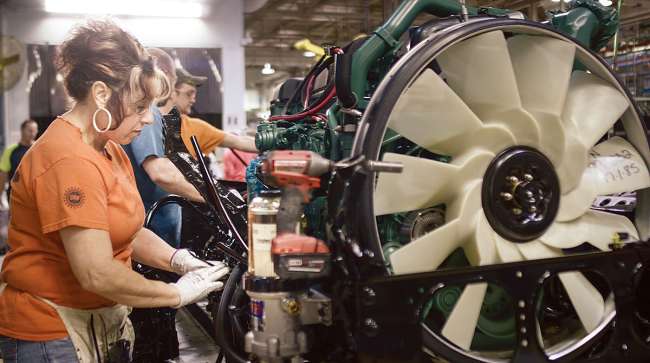
[Stay on top of transportation news: Get TTNews in your inbox.]
The lowest level of North American Class 8 truck orders in modern times is not stopping fleets and engine manufacturers from pushing ahead to prepare for more stringent emission regulations. Companies are finding ways to squeeze out better fuel mileage and uptime performance from the next wave of diesel engines.
“We’re seeing a significant trend toward uptime. That’s the No. 1 characteristic customers are looking for — reliability and durability,” said Landon Sproull, vice president at truck and engine maker Paccar Inc.
“They expect us to provide truck cost of ownership that’s as low as possible with maximum uptime. Fuel economy is a given, that’s now just a ticket to play.”

Sproull
Jim Nachtman, marketing director for Navistar’s heavy-duty product segment, shared a similar sentiment. “The market is heavily focused on reducing total cost of ownership, demanding trucks that are more fuel-efficient with longer service intervals,” he said.
Those challenges will become even more acute as new U.S. Environmental Protection Agency and California Air Resources Board emission standards kick in for 2021, followed by even stricter standards for 2024 and 2027.
“There certainly has been a move toward maximizing fuel efficiency, but that means having the right tool for the job, and choosing the right engine-powertrain configuration,” said Michael Young, Detroit engine marketing manager at Daimler Trucks North America. “It all comes down to the customer use case.”
Fleets are both wary and cautiously optimistic as they collaborate with manufacturers and learn about their plans and strategies for meeting the next phase of greenhouse gas emissions and fuel-economy standards.
Balancing cost and performance as well as ensuring adequate return on investment are key objectives.
Sharing information on needs and collaborating on specs is a road map for a good outcome, said Taki Darakos, vice president of vehicle maintenance and fleet services for Pittsburgh-based less-than-truckload carrier Pitt Ohio Transportation Group.
“We have made it a priority that we work together [with OEMs] to design a spec that will work for us. It’s in their best interest,” he said. “If the product works, we will be happy and buy more.”
Pitt Ohio specs engines for multiple duty cycles, including straight trucks and day cabs for LTL pickup and delivery and heavier-duty linehaul truckload needs.
Most of Pitt Ohio’s straight trucks have a Cummins engine and Eaton transmission on an M2 platform. This year, Darakos also is looking at an M2 with a Detroit engine and Allison transmission.
“You have to stay current and have those relationships with your partners for input and guidance to make educated decisions,” he said.
Pitt Ohio ranks No. 43 on the Transport Topics Top 100 list of the largest for-hire carriers in North America.
Vertical Integration Trend
Manufacturers are increasingly pushing vertically integrated solutions. These offer fleets a “one-stop shop” of chassis, engine and drivetrain blended together and optimized with technology to specific fleet specs and achieve the best cost-performance outcome. The approach is gaining converts, fleets and manufacturers said.
“There is definitely an industry movement toward sourcing proprietary powertrain packages, and with good reason,” Young said. “When all the [components] are engineered and manufactured by the same source, a proprietary communication protocol can be developed that makes for a much smoother, more efficient and safer driver experience.”
He added that vertical integration enables application of remote diagnostics, telematics and engine management tools that report key operating metrics continuously, immediately flag faults and help minimize downtime.
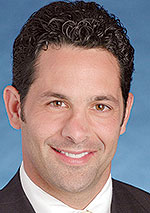
Rosa
“[Vertical integration] is certainly an option. There’s value in that but it’s a question of preference in the application,” said Paul Rosa, senior vice president of procurement and fleet planning for Penske Truck Leasing in Reading, Pa.
Rosa sees the traditional OEMs having an advantage as they have the scale and resources to invest in and refine their single platforms, focused on better fuel economy and uptime. It also makes sense from the perspective of a single source for parts.
John Moore, product marketing manager for Volvo Trucks North America, noted that the majority of the company’s fleet customers prefer its proprietary integrated drivelines.
“Those include enhanced driver productivity, performance and drivability.” he said, citing Volvo’s D13 engine and I-Shift transmission combination as a standard offering.
Raising the Bar
As for the most common demands from customers, Moore said they want to “keep raising the bar on fuel efficiency,” uptime and lower maintenance costs, as well as innovating to meet upcoming greenhouse gas standards.
“The Volvo D13TC turbo compound engine is a technology that uses waste-heat recovery to significantly reduce CO2 output,” he said.“[The engines] have accumulated hundreds of millions of customer-driven miles, proving their effectiveness and reliability.”
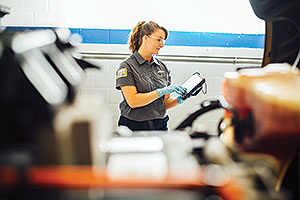
A Pense maintenance technician. Today’s telematics capabilities can show in real time when a fault code occurs, its severity and if immediate attention is needed. (Penske)
Penske Truck Leasing’s Rosa sees several trends shaping Class 8 engine design and performance, including downspeeding, lighter-weight engines, extended maintenance intervals, plus readily available data coming off engines in more real time. These engines have become more reliable and cost-effective with optimized drivetrains and new telematics technologies.
“As a general rule, we’re not having rods come out of the side of an engine anymore,” said Randy Cornell, vice president of maintenance for Joplin, Mo.-based truckload carrier CFI.
Today’s telematics capabilities can show him in real time when a fault code occurs, its severity and if immediate attention is needed.
As engines and drivetrains have incorporated more technology, Cornell opined, “The problem now is having a short somewhere along the wiring harness, or a sensor gone bad, that causes the truck to fail.”
“[Even with sophisticated diagnostic tools available], we still have to go in and find that failure point, which is time consuming and a more difficult challenge,” he added.
13 liter vs. 15 liter
The 15-liter engine has been the industry’s workhorse for years, yet its dominance is being challenged by smaller 13-liter motors, which are lighter weight, quieter and can be tuned to have the same horsepower.
“Customers are becoming a lot more sophisticated at understanding total cost of ownership,” Paccar’s Sproull said. “The 13-liter is lighter weight and has the same amount of power as a 15-liter, and the same durability.”
Sproull noted that the Paccar MX-13 delivers 510 horsepower, which matches up well, power-wise, with a 15-liter. The 13-liter, he said, tends to “run a little bit quieter,” which makes the cabin environment more attractive and comfortable for the driver.
Yet not everyone is jumping on the 13-liter bandwagon.
“I have yet to see a single calendar year of build where the 15-liter has not been the majority engine,” Rosa said. “When you look at residual value, bigger bore is better.”
His viewpoint is echoed by fleets in which a core part of their business model is capturing residual value from a used truck.
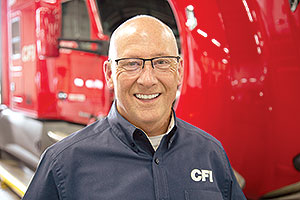
“As a general rule, we’re not having rods come out of the side of an engine anymore,” saiys Cornell of CFI. (CFI)
CFI, for example, “has had great success with a 15-liter engine,” Cornell said. The company maintains an average tractor age of 2 years for its 1,900-tractor fleet. Tractors are cycled out and sold in the secondary market at about 4 years of age, where they still have useful life — and value — for owner-operators and small fleets.
“We find there is more residual value with a 15-liter,” Cornell said. “While there are certainly business models out there where the 13-liter works just fine, in our experience, with the 15-liter, we get more than our money back on the residual value at sale.”
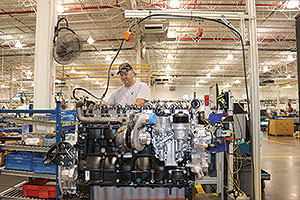
A factory worker on the engine assembly line at a Navistar manufacturing plant. (Navistar)
Jeff Harris, vice president of maintenance for Van Buren, Ark.-based truckload carrier USA Truck, has looked at midbore engine sizes but remains locked into the 15-liter in all his sleeper trucks as well as his day cabs. He specs a Cummins-Eaton drivetrain combination, which comprises 93% of his fleet of Navistar and Kenworth trucks.
Like other truckload carriers, Harris has found in the residual market that a truck with the 15-liter engine is worth $3,000 to $6,000 more when traded in. His fleet average age is about 2.5 years, and this year he is trading out his 2016 models. This month, he also took delivery of 55 new tractors.
Yet he believes the market is starting to change.
“A lot of dynamics in trucking are changing,” he said. “Drivers want to be home every weekend, so that’s pushing toward a more regional-based market. And that market would favor the 13-liter,” he said.
Tracking Fleet Performance
The biggest game changer, Harris believes, continues to be the deployment and refinement of technologies that assist all manner of engine and drivetrain operation, and provide fleet managers unprecedented insight into real-time, on-the-road performance.

Host Seth Clevenger speaks with Mike Perkins and Derrick Loo, test drivers at Peloton Technology, one of the companies at the forefront of developing truck platooning systems. Hear a snippet, above, and get the full program by going to RoadSigns.TTNews.com.
“How [manufacturers] have the engine and transmission working together will just get more refined,” he said, adding that the trend is further increasing fuel economy and reducing emissions. “I can remember that day when we were all excited about getting 6 mpg, now we’re knocking down 8 [mpg].”
Harris said he can pull up a map of the U.S. and see every tractor in his fleet, how they are operating and if they are having any performance issues that need attention.
“To be able to see what’s wrong with a tractor or an engine while it’s moving out in the field is a really interesting aspect we did not have years ago,” he said.
The software being incorporated into engines and drivetrains, along with advanced telematics, sensors and predictive analytics, are rewriting the script for how engines perform and how precisely they can be tuned. These give the engine and drivetrain the ability to “learn” and adjust to its environment for optimal operation.
“Trucks are learning on the road. They know when to coast, how much power they need to navigate a given terrain,” Harris said. “They are using predictive cruise, road speed control, engine torque management, even engine-assisted shifting. It’s really interesting to see how the engine guys have got in tune with the drivetrain guys. And we’re going to see more of that.”
Want more news? Listen to today's daily briefing:




